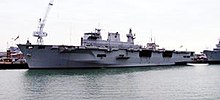| Revision as of 11:12, 8 February 2008 editIngolfson (talk | contribs)Autopatrolled, Extended confirmed users, Pending changes reviewers35,967 editsm Generalising← Previous edit | Revision as of 11:13, 8 February 2008 edit undoIngolfson (talk | contribs)Autopatrolled, Extended confirmed users, Pending changes reviewers35,967 edits WikilinkingNext edit → | ||
| Line 8: | Line 8: | ||
| }} | }} | ||
| An '''amphibious assault ship''' is a type of ] employed to land and support ground forces on enemy territory by an ]. The largest fleet of these types is operated by the ], including the ] dating back to the 1970s and the newer and larger ] ships that debuted in 1989. While often resembling ]s, the role of an amphibious assault ship is fundamentally different: its aviation facilities have the primary role of hosting helicopters to support forces ashore rather than to support strike aircraft. However, they are capable of serving in the ] role, embarking aircraft like Harrier fighters and ASW helicopters. | An '''amphibious assault ship''' is a type of ] employed to land and support ground forces on enemy territory by an ]. The largest fleet of these types is operated by the ], including the ] dating back to the 1970s and the newer and larger ] ships that debuted in 1989. While often resembling ]s, the role of an amphibious assault ship is fundamentally different: its aviation facilities have the primary role of hosting helicopters to support forces ashore rather than to support strike aircraft. However, they are capable of serving in the ] role, embarking aircraft like Harrier fighters and ] helicopters. | ||
| ==History== | ==History== | ||
Revision as of 11:13, 8 February 2008
| This article does not cite any sources. Please help improve this article by adding citations to reliable sources. Unsourced material may be challenged and removed. Find sources: "Amphibious assault ship" – news · newspapers · books · scholar · JSTOR (Learn how and when to remove this message) |
An amphibious assault ship is a type of warship employed to land and support ground forces on enemy territory by an amphibious assault. The largest fleet of these types is operated by the United States Navy, including the Tarawa class dating back to the 1970s and the newer and larger Wasp class ships that debuted in 1989. While often resembling aircraft carriers, the role of an amphibious assault ship is fundamentally different: its aviation facilities have the primary role of hosting helicopters to support forces ashore rather than to support strike aircraft. However, they are capable of serving in the sea-control role, embarking aircraft like Harrier fighters and ASW helicopters.
History
The two nations that have made by far the most amphibious assaults during the past century are the United States and the United Kingdom. From the great assaults of World War II to the recent attack on the Al-Faw Peninsula in Iraq, both countries have been at the forefront of developing amphibious assault doctrine and shipping.
World War II developments
In the Pacific theatre, the escort carriers would often escort the landing ships and troop carriers during the island hopping campaign. In this role, they would provide air cover for the troopships as well as fly the first wave of attacks on the beach fortifications in amphibious landing operations. On occasion they would even escort the large carriers, serving as emergency airstrips and providing fighter cover for their larger sisters while these were busy readying or refueling their own planes. In addition to this, they would also transport aircraft and spare parts from the US to the remote island airstrips.
Early Cold War developments
Despite all the progress that was seen during World War II, there were still fundamental limitations in the types of coastline that were suitable for assault. Beaches had to be relatively free of obstacles, and have the right tidal conditions and the correct slope. However, the development of the helicopter fundamentally changed the equation.

The first use of helicopters in an amphibious assault came during the Anglo-French-Israeli invasion of Egypt in 1956 (the Suez War). Two British light fleet carriers were pressed into service to carry helicopters, and a battalion-sized airborne assault was made. One of these, Bulwark, was commissioned in the late 50s as a dedicated "commando carrier". The techniques were developed further by American forces in the Vietnam War and refined during training exercises. The modern amphibious assault can take place at virtually any point of the coast, making defending against them extremely difficult.
Earlier ships which played a similar role to the current vessels as the heart of an amphibious assault included five Iwo Jima class Landing Platform Helicopter vessels, built in the 1950s and 1960s and various converted fleet and escort carriers. The first of the type envisaged was the escort aircraft carrier USS Block Island (CVE-106/LPH-1), which never actually saw service as an amphibious assault ship. Delays in the construction of the Iwo Jima class saw other conversions made as a stopgap measure; three Essex-class aircraft carriers (USS Boxer (CV-21/LPH-4), USS Princeton (CV-37/LPH-5), and USS Valley Forge (CV-45/LPH-8)) and one Casablanca-class escort carrier (USS Thetis Bay (CVE-90/CVHA-1/LPH-6)) were converted into amphibs, the Boxer and Thetis Bay classes.
The Tarawa and Wasp types and their Iwo Jima class forebears resemble aircraft carriers, as their flight deck allows the use of helicopters and jump jets for supporting amphibious operations.
List of types
- LHA: Landing Helicopter Assault (Tarawa class)
- LHD: Landing Helicopter Dock (Wasp class)
- LPH: Landing Platform Helicopter (Iwo Jima class)
Navies currently operating



- Republic of Korea Navy
- ROKS Dokdo - LPH (Launched in 2005, Commissioned in 3 July 2007)
- Spanish Navy
- Juan Carlos I (LHD1) - LHD (2008)
- Royal Navy
- HMS Ocean (L12) - LPH (1995)
See also
- Amphibious assault submarine
- Amphibious warfare ship
- Escort carrier
- Helicopter carrier
- List of amphibious warfare ships